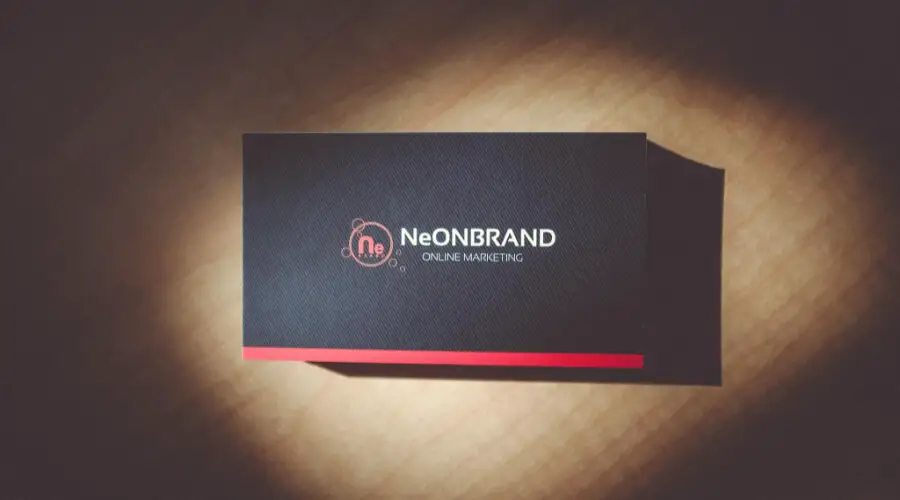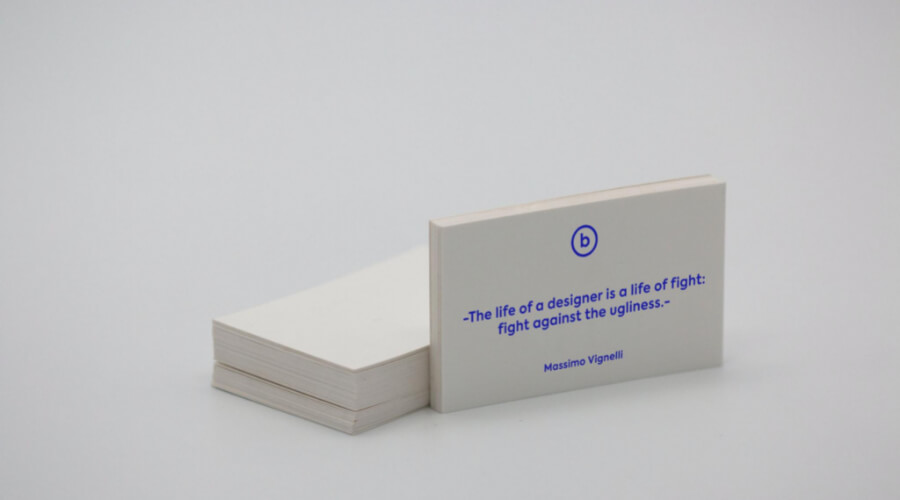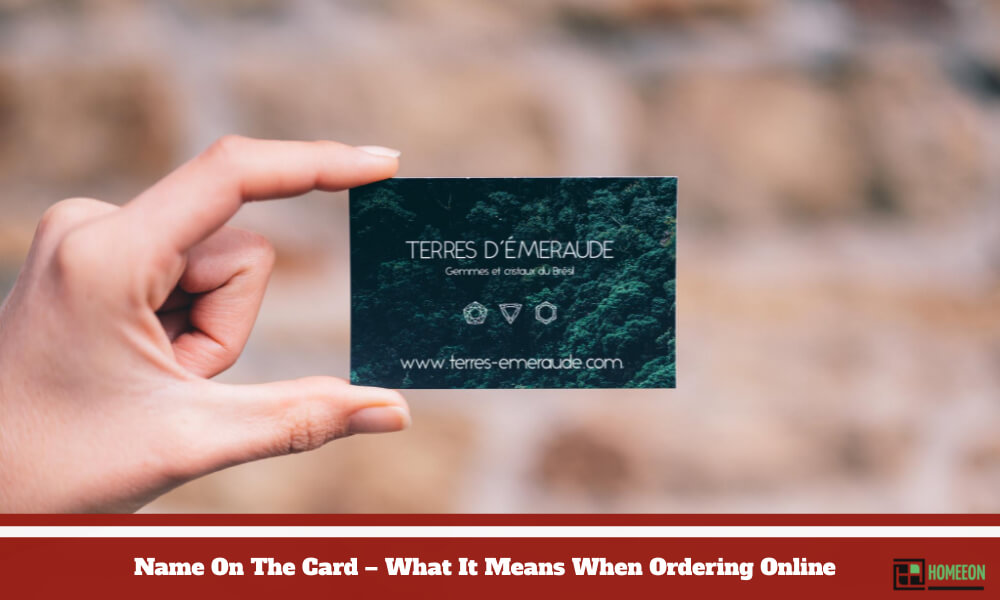Last Updated on July 24, 2023 By Emma W. Thomas
When ordering online, “Name on the card” refers to the name of the cardholder as it appears on the credit or debit card used for payment. It ensures that the person making the purchase is the authorized cardholder, adding an extra layer of security for online transactions.
Name On The Card – What It Means When Ordering Online
The world of online shopping has revolutionized the way consumers purchase products and services. Among the various essential elements of online shopping, the “name on the card” carries significant meaning. This listicle will delve into the importance of the name on the card when ordering online and what it means for both the customer and the business.
1. Verification of the Card Owner
- The name on the card is the initial step for verifying the card’s ownership. It matches the name against what’s in the bank’s records, which helps reduce fraudulent transactions.
2. Billing Address Matching
- Mostly, the name on the card should be the same as the name on the billing address. It acts as a checkpoint for verifying the authenticity of the transaction.
3. Delivery Purposes
- Sometimes, the name on the card might also be used for delivery purposes. In case there’s any confusion, the delivery service could reach out to the person named on the card for clarification.
4. Data Analysis
- Businesses often use the name on the card for analysis and data compilation. This valuable data can be utilized for understanding customer behavior and preferences.
5. Business Records
- The name on the card helps businesses to keep track of individual customer orders. It helps in maintaining comprehensive records of purchases and transactions for future reference.
Below is a table summarizing what the “Name On The Card” means while ordering online:
| S. No. | Purpose | Description |
|---|---|---|
| 1 | Verification | To check the card’s ownership |
| 2 | Address Matching | To ensure authenticity of the transaction |
| 3 | Delivery Purposes | To direct the delivery correctly |
| 4 | Data Analysis | To understand customer behavior |
| 5 | Business Records | To maintain records of individual purchases |
Which name to use when a form asks for “name on card”
When filling out a form that asks for the “name on card,” it is important to provide the correct name that appears on your credit or debit card. It is the name that is associated with the cardholder’s account and plays a crucial role in preventing any payment issues or discrepancies. Here are some key points to consider regarding which name to use:
- Cardholder’s Full Name: The most common and recommended approach is to input the exact name that is printed on the front of your card. This ensures accuracy and consistency in matching the billing information against your card details.
- Middle Initials or Full Middle Name: If your card displays your middle initials or full middle name, it is generally advisable to include it as well. This can help maintain complete alignment between the information provided on the form and the card’s details, minimizing any potential complications during payment processing.
- Hyphenated or Multiple Last Names: If your last name is hyphenated or you have multiple last names, ensure that you include all the names as they appear on your card. This adherence to detail assists in maintaining coherence between the form and the cardholder’s data.
- Nicknames or Shortened Names: Avoid using nicknames, abbreviations, or shortened versions of your name on the form unless explicitly specified. Using your full legal name will help maintain consistency and avoid any confusion during the payment process.
What Are The Main Features Of A Card?

Both credit and debit cards have two sides, i.e. the front and back sides, each with specific features.
On the front
A credit/debit card has the following features on the front;
Bank Brand
Bank branding is a section that identifies the card’s issuer and typically displays your lender’s name. However, some cards may show a logo for a certain program; for example, some will have a retailer’s name or rewards program.
The Name Of The Cardholder
A cardholder is anyone with permission to use funds or spend from the account, also known as the authorized user. While this person may not necessarily open the account, they can use a debit or credit card to make purchases. Although an unauthorized person cannot use a card for purchases, vendors should ask for the ID of the card user before they can accept payments.
A Card Number
Among the most vital parts of your card is the card number. This feature identifies your account with the bank or issuer, and it is what you give out when purchasing online or by phone. These digits range from 14 to 19 depending on the manufacturer, but most cards have 16 digits. A card number needs to remain private to the owner, and one needs to limit the number of people who have access to it.
Be careful not to let unauthorized persons access your card number information since they can use it to purchase. Ensure that your card number remains private, and be careful where you record it. Besides the card number, you will need its expiry date, security code (this is usually a three-digit number on the back of your card), and the postal division on record with the backer of your card for you to shop online. Most merchants will also request the name of the cardholder for purchases.
If the debit card you are using is linked to your financial records, it will have a unique number related to your financial record number.
Smart Chips
These are microscopic metal processors that protect your cards from being used by non-authorized persons. If a thief gets the number of a card that has a chip, they cannot utilize it since it adds a secret code for use to every exchange, making the stolen data less helpful.
Payment Network Logo
Knowing what kind of card you have is very crucial. Standard models integrate Discover, MasterCard, and Visa, which you need to choose when buying online through a drop-down menu. You will also utilize logos when paying for administration or products. Shippers normally display placards or stickers that show the network they acknowledge.
Expiry Date
Your card’s expiration date is crucial when buying online or via phone since most sellers may ask for it. Ensure that you supplant your card regularly since an expired card may not help when you need it. Be sure to check for new cards a few days before their expiration dates since banks mail out new ones before they lapse.
At The Back
A card has significant features at the back that include;
A Magnetic Stripe
A magnetic stripe is a dark strip that consists of your data and that of your card. This strip also contains concentrated gadget information. Whenever you use your card at a merchant, the magnetic stripe is run through a reader that helps to give your payment data. These stripes consist of your card number, name, expiration date, and other important information.
If a hacker runs your card into a card skimming device, they may steal your information and produce a fake card that is similar to yours. Magnetic stripes wear out, especially if you use them frequently, and may also be damaged by strong magnets. If the stripes get damaged, you may get replacement cards having new ones.
Bank Contact Data
The back of your card also contains the contact information of your bank, which you can use to reach it. This information is helpful to protect you from fraud and from contacting the wrong person. If you receive an email or call purporting to be from your bank and whose authenticity you doubt, you can call this number instead of using the one that contacted you. Doing this assures you that you are calling a valid number.
It is advisable to copy your bank contact information and keep it safe. This data will help you to call your bank fast in case you lose your card.
Hologram
A hologram is a mirror-like part of a card that shows a 3-dimensional image that appears to be moving when you change your viewing angle. A hologram is a security feature that merchants use to verify genuine cards. These features are hard to fake and may sometimes be on the front side of your card.
A Signature Panel
Before using your card, you need to sign your name in the signature panel. Ensure that as you sign in, your name fits in this small box. Card issuers require that you put your signature on the card, and it is the responsibility of the merchants to verify that you have done that.
Network Logos
Some cards may have different network logos at the back, usually in the lower-right corner. These features help you to know the ATMs that you can use for free. While you can use other ATMs not listed on the card, you may have to pay some fee to the ATM operator. Using out-of-network ATMs may also attract additional charges from your card issuer or bank.
It is necessary also to know that if you are a member of a credit union, you have a right to utilize several other credit union branches.
Security Codes
Security codes are usually printed on the cards to ensure that only legitimate and original cards are used. When making online payments or by phone, the merchants require that your card has a security code at the back besides having an expiry date and card number at the front. Security codes make it difficult for hackers to use your cards if they steal them from the merchants’ systems or by using a skimmer.
For most websites, you will be required to type the security code on your card in a small box. This code is a three-digit number on the back of your Visa, Discover, or Mastercard. Before the security code, you will find your card’s last four-digit number. The four-digit security code for the American Express cards is on the front side, normally at the top right corner.
Like every other information on your card, the security code is critical and needs to be kept private.
How Can You Use Your Card?

Besides using your card to make payments for your purchases, there are several other ways you can use it including;
Online Buying
When making online purchases, using a credit card is safer than a debit card. A credit card will give you better consumer protection and protect your account from problems. But, it is important to make timely payments for your credit card to avoid interest charges.
Getting Cash
It is possible to withdraw cash from your bank account using both credit and debit cards. However, it is best to withdraw cash using a debit card since cash advances are expensive and interest rates are high.
Paying Bills
Your cards come in handy when you want to pay your bills faster and from one or two accounts. You can choose to pay online, by mail, or using your phone. When paying for bills, it is preferable to use a credit instead of a debit card. Using a credit card helps to prevent a domino effect whenever issues arise from your payment.
Sending Money
You can conveniently send funds to friends, family, or anyone else using your card. Several services and apps are available to let you make payments using both credit and debit cards. A good example is the Cash app which allows you to receive and send funds for free using your debit card. Another example is Venmo which is convenient to use.
What Are The Differences Between Debit And Credit Cards?
Debit Card | Credit Card |
| Deducts money from your bank account directly | Allows you access credit from your bank |
May not guarantee consumer protection against fraud since it is linked to your account. | Gives you better consumer protection against fraud |
No access to discounts or travel points | You can get travel points and discounts when using rewards cards. |
You don’t get additional warranties and protection in case of defective items. | You can get insurance or warranties on purchased items in case of defects. |
You cannot dispute or reverse a charge unless the vendor is willing to do so | You can dispute unauthorized purchases or damage of items during shipping. |
Conclusion
A name on a card is crucial when making purchases online since it shows the legitimate user of the card. This name is the one issued by your bank or issuer when you are signing up for it. A merchant will ask for the name beside other details like expiry date, security code, and card number.
Always ensure that you keep your card information private since exposing it may give fraudsters access to your funds.
References:
https://linguaholic.com/linguablog/name-on-card/
https://grammarhow.com/name-on-card/
Emma is a graduate of Domestic Science or Family and Consumer Sciences (Home Economics) from the University of Wisconsin. She has 7 years of experience Working with the strategic section of BestBuy and now writing full-time for Homeeon.
From Managing the Home, Interiors, Cleaning, and Exteriors to Gardening and everything about Making A Home Liveable – is her passion and this Homeeon is the result of this.
Emma loves decorating her home with the best stuff found online. She cares about quality over anything and writes reviews about them here in Homeeon. Get in touch with her over Pinterest.
Keep reading her blogs.

